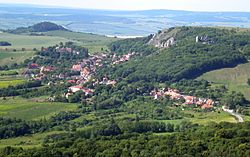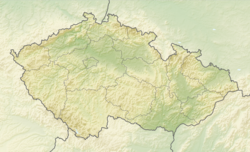Klentnice (German: Klentnitz) is a municipality and village in Břeclav District in the South Moravian Region of the Czech Republic. It has about 500 inhabitants.
Klentnice | |
|---|---|
 Klentnice seen from Děvín | |
| Coordinates: 48°50′41″N 16°38′41″E / 48.84472°N 16.64472°E | |
| Country | |
| Region | South Moravian |
| District | Břeclav |
| First mentioned | 1322 |
| Area | |
| • Total | 7.69 km2 (2.97 sq mi) |
| Elevation | 334 m (1,096 ft) |
| Population (2024-01-01)[1] | |
| • Total | 484 |
| • Density | 63/km2 (160/sq mi) |
| Time zone | UTC+1 (CET) |
| • Summer (DST) | UTC+2 (CEST) |
| Postal code | 692 01 |
| Website | www |
Geography
editKlentnice is located about 20 kilometres (12 mi) northwest of Břeclav and 37 km (23 mi) south of Brno. It lies in the Mikulov Highlands. The village is situated on the eastern slope of the hill Stolová hora at 459 m (1,506 ft) above sea level. The highest point of the municipality is the slope of the hill Obora with an elevation of about 465 m (1,526 ft). Klentnice is located in the Pálava Protected Landscape Area.
History
editGrave findings of the La Tène culture are documents of an early settlement. In the times of Great Moravia, the area was inhabited by the Slavs. After the empire fell, the inhabitants were replaced by German colonists. The first written mention of Klentnice is from 1322, when it was part of the Mikulov estate.[2]
As a part of the Mikulov estate, it was owned by the House of Liechtenstein. They contributed to cultural and ethnic enrichment when they invited Jews and Anabaptists. In 1560, the Liechtensteins sold the estate to the Kerecseny family. In 1575, the estate was donated to the Dietrichstein family by Emperor Maximillian II. During their rule in the second half of the 17th century and in the 18th century, the estate prospered and developed.[2]
After World War I, the multi-ethnic state Austria-Hungary was split up. By the Treaty of Saint-Germain-en-Laye, Klentnice became part of the newly established Czechoslovakia. Following the Munich Agreement, the municipality belonged to the Reichsgau Niederdonau until 1945. After World War II, the municipality fell back to Czechoslovakia and the German population was expelled. The town was recolonized by ethnic Czechs mainly from Moravian Slovakia.[2]
Demographics
edit
|
|
| ||||||||||||||||||||||||||||||||||||||||||||||||||||||
| Source: Censuses[3][4] | ||||||||||||||||||||||||||||||||||||||||||||||||||||||||
Transport
editThere are no railways or major roads passing through the municipality.
Sights
editThe Church of Saint George was first mentioned in 1582. The today's structure was built in 1783–1785.[2]
The ruin of the Sirotčí hrádek castle is located above the village. The castle was founded at the turn of 13th and 14th centuries. It was abandoned before 1590 and referred to as completely desolated in 1629.[5]
References
edit- ^ "Population of Municipalities – 1 January 2024". Czech Statistical Office. 2024-05-17.
- ^ a b c d "Historie" (in Czech). Obec Klentnice. Retrieved 2021-11-29.
- ^ "Historický lexikon obcí České republiky 1869–2011" (in Czech). Czech Statistical Office. 2015-12-21.
- ^ "Population Census 2021: Population by sex". Public Database. Czech Statistical Office. 2021-03-27.
- ^ "Sirotčí hrádek – dominanta Pavlovských vrchů" (in Czech). CzechTourism. Retrieved 2021-11-29.


